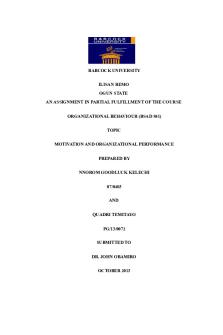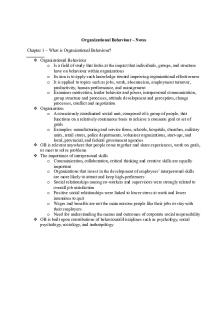Organizational Behaviour mcqs PDF

| Title | Organizational Behaviour mcqs |
|---|---|
| Author | nimble management |
| Course | Organizational Development |
| Institution | Savitribai Phule Pune University |
| Pages | 27 |
| File Size | 331.5 KB |
| File Type | |
| Total Downloads | 298 |
| Total Views | 507 |
Summary
Organizational Behavior Page 1Dr. D. Y. Patil Institute of Management & Entrepreneur DevelopmentTalegaon varale------------------------------------------------------------------------------------------------MCQs FORORGANISATIONAL BEHAVIOURBy, Prof Ramteke “-----------are social inventions fo...
Description
Dr. D. Y. Patil Institute of Management & Entrepreneur Development Talegaon varale -----------------------------------------------------------------------------------------------MCQs FOR
ORGANISATIONAL BEHAVIOUR By, Prof.Shubhangi Ramteke 1. “-----------are social inventions for accomplishing goals through group efforts” a. Management c. Leadership b. Organizatio d. Behavior n 2. Which of the following is/are the key features of organization a. Social invention c. Group efforts b. Accomplishing goals d. All of these 3. A study of human behavior in organizational settings is a. Individual behavior c. Organizational behavior b. Group behavior d. None of these 4. Scientific Management approach is developed by a. Elton Mayo c. F.W. Taylor b. Henry Fayol d. A. Maslow 5. Who proposed “ bureaucratic structure” is suitable for all organization a. Elton Mayo c. F.W. Taylor b. Henry Fayol d. Max Weber 6. “Hawthrone experiment” which was a real beginning of applied research in OB was conducted by a. Elton Mayo c. F.W. Taylor b. Henry Fayol d. Max Weber 7. Process or administrative theory of organization is being given by a. Elton Mayo c. F.W. Taylor b. Henry Fayol d. Max Weber 8. Whose concept states that interpersonal and human relations may lead to productivity a. Elton Mayo c. F.W. Taylor b. Henry Fayol d. Max Weber 9. Today’s organization are a. Open system c. Open as well as closed b. Closed system d. None of these
Organizational Behavior
Page 1
10. Which organization theory can be understood by IF and THEN relationship a. System approach c. Process approach b. Contingency approach d. Scientific approach 11. Organization Behavior is a. An interdisciplinary approach c. Total system approach b. A humanistic approach d. All of these 12. Organization Behavior is not a /an a. A separate field of study c. Normative science b. Applied science d. Pessimistic approach 13. “Cognitive theory” of learning was given by a. Skinner c. Tolman b. Pavlov d. Piajet 14. Extension of behavior modification into organization is called a. Enrichment c. OB Mod b. Enlargement d. OB Ext 15---------------is a relatively permanent change in behavior that occurs as a result of experience a. Behavior modification c. Motivation b. Learning d. Skills 16. which of the following is / are included as structure of human mind a. Id c. Super ego b. Ego d. All the above 17is largely childish, irrational, never satisfied, demanding and destructive of others a. Ego c. Negative ego b. Super ego d. Id 18represent noblest thoughts, ideals etc. a. Ego c. Negative ego b. Super ego d. Id 19is reality and practical oriented part of thinking a. Ego b. Super ego
c. Negative ego d. Id 20. Thematic Apperception Test (TAT) is designed to understand a. Perception of individual c. Learning of individual b. Personality of individual d. None of these
21------------------is “the reactions of individuals to new or threatening factors in their work environments” a.Attitude c.Dissonance b.Stress d.Disappointment 22. Which of the following is/are not job related source of stress a.Role ambiguity c.Ethical dilemmas b.Role overload d.Career concerns 23. Which of the following is/are not organizational factors causing stress a. Task demand c. Role conflict b.Role demand d.Satisfaction
24. Which of the following is / are method of managing stress a. Job relocation c. Recreational facility b. Career counseling d. All the above 25. Which of the following is / are not a method of managing stress a. Time management c. Role Analysis techniques (RAT) b. Supervisor training d. Rorschach test 26----------------refers to the negotiation or an agreement between two groups a. Contracting c. Pressure tactics b. Co-opting d. None of these 27. Which of the following methods is/are used to solve intergroup conflicts indirectly a. Avoidance c. Bargaining b. Encouragement d. All of these 28. Which of the following is / are not direct method to solve intergroup conflicts a. Problem solving c. Removing key figures in conflict b. Domination by the management d. Persuasion 29. A technique to bring changes in the entire organization, rather man focusing attention on individuals to bring changes easily. a. Organizational development c. Organizational culture b. Organizational change d. Organizational conflicts 30. Which of the following is/are OD intervention techniques a. Sensitivity training c. Quality of work life b. MBO d. All the above 31. Which of the following is NOT an important issue relating to goal-setting theory? a. Goal specificity c. Feedback b. Equity among workers d. Defining the goal 32. Behaviour, power, and conflict are central areas of study for . a. sociologist b. Anthropologists c. Social psychologists d. Operations analysts 33. When a bank robber points a gun at a bank employee, his base of power is: a. Coercive b. Punitive c. Positional d. Authoritative 34. The managers of a multinational company are located in France, India, Brazil, and the United States. Which decision-making technique seems most reasonable for this organization? a. A postal service interaction b. A brainstorming session c. A nominal discussion d. An electronic meeting 35. What do we call it when we judge someone on the basis of our perception? a. Stereotyping b. Categorizing c. Halo effect d. Prototyping 36. Sobha is an honest and straightforward person. She believes her employees are all similarly honest and straightforward, ignoring signs that they may be manipulating her. What perceptual shortcut is Sobha most likely using? Organizational Behavior
Page 3
a. Contrast effect c. Stereotyping
Organizational Behavior
b. Halo effect d. Projection
Page 4
37. Sathish has a low absenteeism rate. He takes responsibility for his health and has good health habits. He is likely to have a(an): a. Internal locus of control b. External locus of control c. Core locus of control d. High emotional stability level 38. Raju believes that men perform better in oral presentations than women. What shortcut has been used in this case? a. The halo effect b. The contrast effect
c. Projection d. Stereotyping
39. Mr. Manoj, Manager ABC Company found that skills of workers and machinery used by them as compared to the competitors in the market are obsolete within a year, which type of challenge ABC Company is facing? a. High Quality and Low Quality c. Rapid Pace of Change
b. Globalization and Culture d. Multiple Stakeholders
40. According to Robert Katz, when managers have the mental ability to analyze and diagnose complex situations, they possess skills. a. Technical b. Leadership c. Problem-solving d. Conceptual 41. What sort of goals does Management By Objectives (MBO) emphasize? a. Tangible, verifiable and measurable b. Achievable, controllable and profitable
c. Challenging, emotional and constructive d. Hierarchical, attainable and effective
42. Today’s managers understand that the success of any effort at improving quality and productivity must include . a. Quality management programs c. Employee's participation b. Customer service improvements d. Manufacturing simplification 43. Which of the following would be least likely to pose a barrier to cross-cultural communications? a. Tone difference b. Word connotations
c. Political correctness d. Differences among perceptions 44. Which of the following theory is proposed by Clayton Alderfer? a. Theory X and Theory Y c. ERG Theory 45. Concept of MBO was introduced by: a. Peter. F.Drucker b. Mary Parker
b. Hierarchy of Needs d. Theory c. Henry Fayol d. Philip Kotler
46. Mr. Sunil’s one-day salary was deducted because of his uninformed leave, as he was already warned about this behaviour. It is an example of which method of shaping behaviours?
a.Reinforcement b. Positive Reinforcement
c. punishment d. Negative Reinforcement
47. While managing political behaviours in organization, the manager requires discouraging: a. Negotiation b. Relationships c. Self interest d. Dialogue 48. People with which type of personality trait commonly make poor decisions because they make them too fast? a. Type As c. Self-monitors b. Type Bs d. Extroverts 49. Which of the following is an environmental force that shapes personality? a. Gender c. Experience b. Height d. Brain size 50. Factors other than satisfaction that impact one’s decision to leave a current job include all of the following EXCEPT: a. Labour market conditions c. Organizational citizenship behavior b. Length of tenure with the organization d. Expectations about alternative job opportunities 51. Praveen is dissatisfied with his job but believes that his supervisor is a good man who will do the right thing. Praveen has decided that if he just waits, conditions will improve. Praveen’s approach to this problem is termed as: a. Exit c. Loyalty b. Voice d. Neglect 52. Which of the following leadership behaviours are identified by the path-goal theory? a. Supportive, employee-oriented, laissez-faire and participative b. Achievement-oriented, supportive, humanistic, and directive c. Participative, achievement-oriented, directive, and supportive d. Directive, participative, supportive, and laissez-faire 53. Which of the following is not a trait dimension in Big 5 personality trait? a. Extroversion c. Ego b. Agreeableness d. Culture 54. In which stage of the conflict process does conflict become visible? a. Illumination c. Behaviour b. Intentions d. Cognition 55. Which dimension of Big 5 personality traits represents artistically sensitive, refined etc. a. Culture c. Conscientiousness b. Emotional stability d. Extroversion 56. refers to the network of personal and social relations that is developed spontaneously between people associated with each other. a. Formal organization c. Business organization b. Informal organization d. Government organization 57. The cognitive process through which an individual selects, organizes but misinterprets environmental stimuli is known as a. Perception b. Projection
c. Selective Perception d. MisPerception
58. The more consistent behaviour, the more the observer is inclined to _. a. Attribute it to interpretation c. Attribute it to consensus b. Attribute it to internal causes d. Attribute it to external causes 59. Which of the following is one of the relationships proposed in expectancy theory? a. Reward-satisfaction relationship c. Rewards-personal goals relationship b. Satisfaction-performance relationship d. Effort-satisfaction relationship 60. In Maslow’s hierarchy needs which of the following pair of needs is ranked as” lower order needs”? a. Physiological and safety needs c. Self actualization and safety needs b. Physiological and social need d. Social and esteem needs 61. Maslow grouped the five needs into two categories a. Higher-order needs and Lower-order needs. c. Self needs and others needs b. Supreme needs and local needs d. Luxurious needs and comfort needs 62. If everyone who is faced with a similar situation responds in the same way, attribution theory states that the behaviour shows . a. Consensus c. Reliability b. Similarity d. Consistency 63. Your boss never gives you the benefit of the doubt. When you were late back from lunch, he assumed that you had simply taken too much time. He never considered that the elevators were out and you had to walk up 10 flights of stairs. Your boss is guilty of . a. Self-serving bias c. Fundamental attribution error b. Selective perception d. Inconsistency 64. Mr.Sajeev rated Mr. Rajiv high in his job evaluation because both belong to same area and graduated from the same University. It is an example of: a. Central Tendency c. Similar-to-me effect b. Halo effect d. Misperception 65. All the following are dimensions of Intellectual ability EXCEPT: a. Inductive reasoning c. Deductive reasoning b. Dynamic strength d. Number aptitude 66. What sort of actions is most likely to be attributed to external causes? a. Actions that have high distinctiveness, high consensus and high consistency b. Actions that have high distinctiveness, high consensus and low consistency c. Actions that have high distinctiveness, low consensus and low consistency d. Actions that have low distinctiveness, low consistency and high consensus 67. A threatened strike action by a labour union to force the management to accept their demands is an example of which of the following power? a. Referent power c. Reward power b. legitimate power d. Coercive power 68. Which of the following departmentalization can be considered necessary in an organization where the company’s products fall into several categories with very different production methods for each category? a. Customer b. Production
c. Process d. Matrix
69. Mr.Dirash has a job which pays an excellent salary. He has a good relationship with his peers and his supervisors. He also likes the fact that the company policy fits well with what he personally believes, and that he has received considerable recognition for his achievements at the company. Which of these factors is 'MOST likely' responsible for the fact that Dirash loves his job? a. High compensation c. Good nature of supervisor relationships b. Good nature of peer relationships d. Recognition for his achievements 70. Job appraisal is the part of_ a. Sociology b. Anthropology
c. Psychology d. Political science
71. Over the past two decades, business schools have added required courses on people skills to many of their curricula. Why have they done this? a. Managers no longer need technical skills in subjects such as economics and accounting to succeed. b. There is an increased emphasis in controlling employee behavior in the workplace. c. Managers need to understand human behavior if they are to be effective. d. These skills enable managers to effectively lead human resources departments. 72. Which of the following is most likely to be a belief held by a successful manager? a. Technical knowledge is all that is needed for success. b. It is not essential to have sound interpersonal skills. c. Technical skills are necessary, but insufficient alone for success. d. Effectiveness is not impacted by human behavior. 73. What term is used for the extent to which an individual displays different behaviours in different situations? c. flexibility a. continuity d. distinctiveness b. integrity 74. What does consensus refer to in attribution theory? a. There is general agreement about a perception. b. Different people respond the same way in the same situation. c. There is general agreement about how people desire to respond to the same situation. d. Different people perceive a situation similarly. 75. If everyone who is faced with a similar situation responds in the same way, attribution theory states that the behaviour shows. a. consensus c. reliability b. similarity d. consistency 76. Which of the following is not one of the four primary management functions? a. Controlling c. Staffing b. Planning d. organizing 77. Determining how tasks are to be grouped is part of which management function? a. Planning c. Controlling b. Leading d. organizing
78. Mintzberg concluded that managers perform 10 different, highly interrelated roles. Which of the following is one of the broad categories into which these roles could be grouped? a. Intrapersonal b. Institutional
c. Decisional d. affective
79. As a manager, one of James’s duties is to present awards to outstanding employees within his department. Which Mintzberg managerial role is James acting in when he does this? a. leadership role c. monitor role b. liaison role d. figurehead role 80. According to Mintzberg, one of management’s interpersonal roles is . a. spokesperson c. Negotiator b. leader d. monitor 81. Robert Katz identified three essential skills that managers need to have in order to reach their goals. What are these skills? a. technical, decisional and interpersonal b. technical, human, and conceptual c. interpersonal, informational and decisional d. conceptual, communication and networking 82. A manager is valued by her colleagues for her ability to perform effective break-even analysis on upcoming ventures. In this case, her colleagues value her for competencies that fall within which of Katz’s essential management skills categories? a. Technical b. Communication
c. Human d. conceptual
83. According to Katz, technical skills encompass the ability to. a. analyze and diagnose complex situations b. exchange information and control complex situations c. apply specialized knowledge or expertise d. initiate and oversee complex projects 84. Which one of the following would not be considered a human skill in Katz’s structure? a. Decision making. c. resolving conflicts b. Communicating d. working as part of a team 85. According to Katz, when managers have the mental ability to analyze and diagnose complex situations, they possess skills. a. Technical c. problem-solving b. Leadership d. conceptual 86. According to Fred Luthans and his associates, which of the following is considered a part of traditional management? a. Disciplining c. exchanging routine information b. decision making d. acquiring resources 87. Which of Luthans’ managerial activities involves socializing, politicking, and interacting with outsiders? a. traditional management b. communicating
c. human resource management d. networking
88. While the Functions, Roles, Skills, and Activities approaches to management all differ, they all recognize that effective and successful managers must develop which of the following? a. People skills c. Efficiency d. entrepreneurialism b. technical skills 89. An OB study would be least likely to be used to focus on which of the following problems? a. an increase in absenteeism at a certain company b. a fall in productivity in one shift of a manufacturing plant c. a decrease in sales due to growing foreign competition d. an increase in theft by employees at a retail store 90. If a person responds the same way over time, attribution theory states that the behaviour shows. a. Distinctiveness c. Consistency b. Consensus d. continuity 91. Mr.Balu is late for work each day by about ten minutes. How would attribution theory describe this behaviour? a. It shows consensus. c. It shows reliability. b. It shows similarity. d. It shows consistency 92. Which of the following is a reason that the study of organizational behaviour is useful? a. Human behavior does not vary a great deal between individuals and situations. b. Human behavior is not random. c. Human behavior is not consistent. d. Human behavior is rarely predictable. 93. Psychology’s major contributions to the field of organizational behavior have been primarily at what level of analysis? a. the level of the group c. the level of the organization b. the level of the individual d. the level of the culture 94. Which behavioural science discipline is most focused on understanding individual behaviour? a. Sociology c. Psychology b. social psychology d. anthropology 95. The science that seeks to measure, explain, and sometimes change the behaviour of humans and other animals is known as . c. Sociology a. Psychiatry d. organizational behavior b. Psychology 96. blends concepts from psychology and sociology. a. Corporate strategy b. Anthropology
c. Political science. d. Social psychology
97. The science that focuses on the influence people have on one another is. a. Psychology c. political science b. Anthropology d. social psychology 98. Which of the following fields has most helped us understand differences in fundamental values, attitudes, and behaviour among people in different countries? a. Anthropology b. Psychology
c. political science d. operations research
99. The subject of organizational culture has been most influenced by which behavioural science discipline? a. Anthropology c. social psychology b. Psychology d. political science 100. Which of the following OB topics is not central to managing employees’ fears about terrorism? a. Em...
Similar Free PDFs
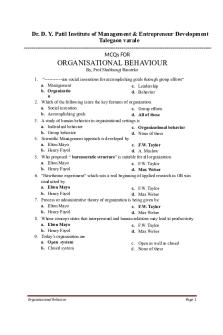
Organizational Behaviour mcqs
- 27 Pages
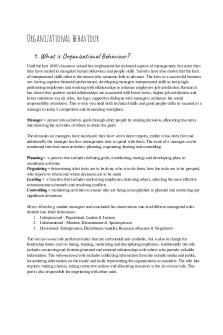
Organizational behaviour
- 67 Pages

Organizational Behaviour
- 2 Pages
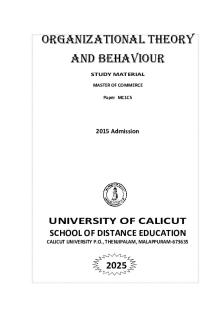
Organizational theory and behaviour
- 186 Pages
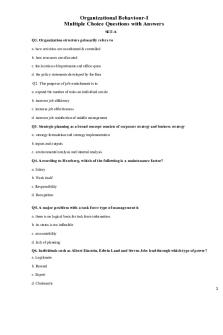
Organizational Behaviour MCQ SET
- 20 Pages
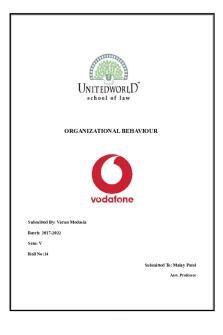
Organizational Behaviour Project
- 15 Pages

Chapter 2 ORGANIZATIONAL BEHAVIOUR
- 23 Pages

Organizational Behaviour Glossary
- 17 Pages
Popular Institutions
- Tinajero National High School - Annex
- Politeknik Caltex Riau
- Yokohama City University
- SGT University
- University of Al-Qadisiyah
- Divine Word College of Vigan
- Techniek College Rotterdam
- Universidade de Santiago
- Universiti Teknologi MARA Cawangan Johor Kampus Pasir Gudang
- Poltekkes Kemenkes Yogyakarta
- Baguio City National High School
- Colegio san marcos
- preparatoria uno
- Centro de Bachillerato Tecnológico Industrial y de Servicios No. 107
- Dalian Maritime University
- Quang Trung Secondary School
- Colegio Tecnológico en Informática
- Corporación Regional de Educación Superior
- Grupo CEDVA
- Dar Al Uloom University
- Centro de Estudios Preuniversitarios de la Universidad Nacional de Ingeniería
- 上智大学
- Aakash International School, Nuna Majara
- San Felipe Neri Catholic School
- Kang Chiao International School - New Taipei City
- Misamis Occidental National High School
- Institución Educativa Escuela Normal Juan Ladrilleros
- Kolehiyo ng Pantukan
- Batanes State College
- Instituto Continental
- Sekolah Menengah Kejuruan Kesehatan Kaltara (Tarakan)
- Colegio de La Inmaculada Concepcion - Cebu
